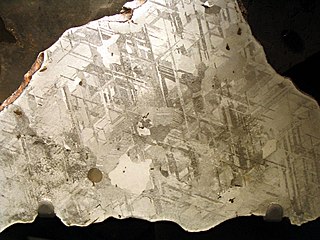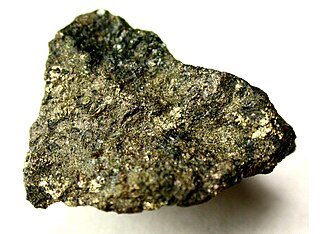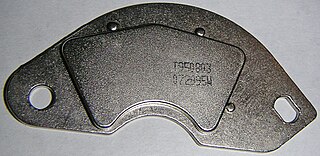
Ferromagnetism is a property of certain materials that results in a significant, observable magnetic permeability, and in many cases, a significant magnetic coercivity, allowing the material to form a permanent magnet. Ferromagnetic materials are familiar metals that are noticeably attracted to a magnet, a consequence of their substantial magnetic permeability. Magnetic permeability describes the induced magnetization of a material due to the presence of an external magnetic field. This temporarily induced magnetization, for example, inside a steel plate, accounts for its attraction to the permanent magnet. Whether or not that steel plate acquires a permanent magnetization itself depends not only on the strength of the applied field but on the so-called coercivity of the ferromagnetic material, which can vary greatly.

Kamacite is an alloy of iron and nickel, which is found on Earth only in meteorites. According to the International Mineralogical Association (IMA) it is considered a proper nickel-rich variety of the mineral native iron. The proportion iron:nickel is between 90%:10% and 95%:5%; small quantities of other elements, such as cobalt or carbon may also be present. The mineral has a metallic luster, is gray and has no clear cleavage although its crystal structure is isometric-hexoctahedral. Its density is about 8 g/cm3 and its hardness is 4 on the Mohs scale. It is also sometimes called balkeneisen.

Nickel is a chemical element with symbol Ni and atomic number 28. It is a silvery-white lustrous metal with a slight golden tinge. Nickel is a hard and ductile transition metal. Pure nickel is chemically reactive, but large pieces are slow to react with air under standard conditions because a passivation layer of nickel oxide forms on the surface that prevents further corrosion. Even so, pure native nickel is found in Earth's crust only in tiny amounts, usually in ultramafic rocks, and in the interiors of larger nickel–iron meteorites that were not exposed to oxygen when outside Earth's atmosphere.

Octahedrites are the most common structural class of iron meteorites. The structures occur because the meteoric iron has a certain nickel concentration that leads to the exsolution of kamacite out of taenite while cooling.

Pentlandite is an iron–nickel sulfide with the chemical formula (Fe,Ni)9S8. Pentlandite has a narrow variation range in nickel to iron ratios (Ni:Fe), but it is usually described as 1:1. In some cases, this ratio is skewed by the presence of pyrrhotite inclusions. It also contains minor cobalt, usually at low levels as a fraction of weight.

A neodymium magnet (also known as NdFeB, NIB or Neo magnet) is a permanent magnet made from an alloy of neodymium, iron, and boron to form the Nd2Fe14B tetragonal crystalline structure.

Periclase is a magnesium mineral that occurs naturally in contact metamorphic rocks and is a major component of most basic refractory bricks. It is a cubic form of magnesium oxide (MgO). In nature it usually forms a solid solution with wüstite (FeO) and is then referred to as ferropericlase or magnesiowüstite.

Alnico is a family of iron alloys which in addition to iron are composed primarily of aluminium (Al), nickel (Ni), and cobalt (Co), hence the acronym al-ni-co. They also include copper, and sometimes titanium. Alnico alloys are ferromagnetic, and are used to make permanent magnets. Before the development of rare-earth magnets in the 1970s, they were the strongest type of permanent magnet. Other trade names for alloys in this family are: Alni, Alcomax, Hycomax, Columax, and Ticonal.
Magnetic shape memory alloys (MSMAs), also called ferromagnetic shape memory alloys (FSMA), are particular shape memory alloys which produce forces and deformations in response to a magnetic field. The thermal shape memory effect has been obtained in these materials, too.

Widmanstätten patterns, also known as Thomson structures, are figures of long nickel–iron crystals, found in the octahedrite iron meteorites and some pallasites. They consist of a fine interleaving of kamacite and taenite bands or ribbons called lamellae. Commonly, in gaps between the lamellae, a fine-grained mixture of kamacite and taenite called plessite can be found. Widmanstätten patterns describe features in modern steels, titanium, and zirconium alloys.

Cohenite is a naturally occurring iron carbide mineral with the chemical structure (Fe, Ni, Co)3C. This forms a hard, shiny, silver mineral which was named by E. Weinschenk in 1889 after the German mineralogist Emil Cohen, who first described and analysed material from the Magura meteorite found near Slanica, Žilina Region, Slovakia. Cohenite is found in rod-like crystals in iron meteorites.

Meteoric iron, sometimes meteoritic iron, is a native metal and early-universe protoplanetary-disk remnant found in meteorites and made from the elements iron and nickel, mainly in the form of the mineral phases kamacite and taenite. Meteoric iron makes up the bulk of iron meteorites but is also found in other meteorites. Apart from minor amounts of telluric iron, meteoric iron is the only naturally occurring native metal of the element iron on the Earth's surface.

Taenite is a mineral found naturally on Earth mostly in iron meteorites. It is an alloy of iron and nickel, with a chemical formula of Fe,Ni and nickel proportions of 20% up to 65%.

An iron–nickel alloy or nickel–iron alloy, abbreviated FeNi or NiFe, is a group of alloys consisting primarily of the elements nickel (Ni) and iron (Fe). It is the main constituent of the "iron" planetary cores and iron meteorites. In chemistry, the acronym NiFe refers to an iron–nickel catalyst or component involved in various chemical reactions, or the reactions themselves; in geology, it refers to the main constituents of telluric planetary cores.
Antitaenite is a meteoritic metal alloy mineral composed of iron (Fe) and 20–40% nickel (Ni), that has a face centered cubic crystal structure.

Haxonite is an iron nickel carbide mineral found in iron meteorites and carbonaceous chondrites. It has a chemical formula of (Fe,Ni)23C6, crystallises in the cubic crystal system and has a Mohs hardness of 5+1⁄2 - 6.

At atmospheric pressure, three allotropic forms of iron exist, depending on temperature: alpha iron, gamma iron, and delta iron (δ-Fe). At very high pressure, a fourth form exists, epsilon iron. Some controversial experimental evidence suggests the existence of a fifth high-pressure form that is stable at very high pressures and temperatures.
Akimotoite is a rare silicate mineral in the ilmenite group of minerals, with the chemical formula (Mg,Fe)SiO3. It is polymorphous with pyroxene and with bridgmanite, a natural silicate perovskite that is the most abundant mineral in Earth's silicate mantle. Akimotoite has a vitreous luster, is colorless, and has a white or colorless streak. It crystallizes in the trigonal crystal system in space group R3. It is the silicon analogue of geikielite (MgTiO3).
Allabogdanite is a very rare phosphide mineral with the chemical formula (Fe,Ni)2P, found in 1994 in a meteorite. It was described for an occurrence in the Onello meteorite in the Onello River basin, Sakha Republic; Yakutia, Russia; associated with taenite, schreibersite, kamacite, graphite and awaruite. It was named for Russian geologist Alla Bogdanova.

Braggite is a sulfide mineral of platinum, palladium and nickel with chemical formula: S. It is a dense, steel grey, opaque mineral which crystallizes in the tetragonal crystal system. It is the central member in the platinum group end-members cooperite and vysotskite.












